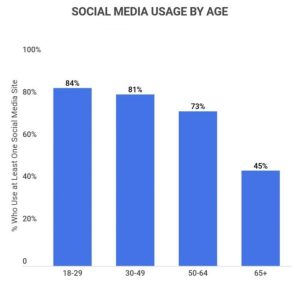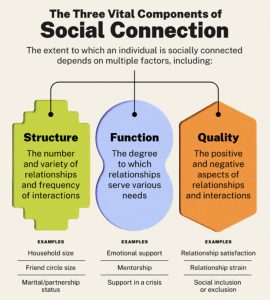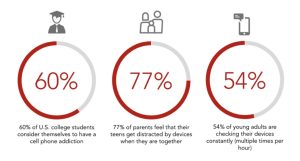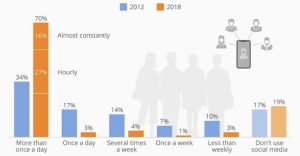5 Is Social Media Actually Social?
Loren Ely
Author Biography
Loren Ely is a third-year transfer to Utah State University. She is originally from Kalamazoo, Michigan, but has been in Utah for a year and loves it more than anything. She has various hobbies, including piano, crochet, dirt biking, camping, hiking, and all things outdoors. During the summer, she works in Zion National Park as a wrangler and tour guide and hopes to one day open her own ranch down south.
Writing Reflection
Since I was young, writing has been an outlet for me to express inner thoughts, ideas, and pictures, and it was a way to feel creative. Most of that sticks to the journal. But, after being prompted to write for English 2010, I was challenged to let my peers access those thoughts, which was very uncomfortable. Eventually, I could write about things that mattered to me from experience and allow my peers to get to know me through my words. That experience was freeing, and I am now inspired to continue writing and share it with others.
This essay was composed in April 2023 and uses MLA documentation.
A young girl begs her mom for Instagram after seeing her friends with it at school. After hesitation, her mom wants her to feel included. She is 12, so she has to lie about her age. Opening the app is like having a backstage pass to the world: people’s lives, gossip, videos, news, inspo pics. She scrolls occasionally to see what her friends are up to but doesn’t fully experience the perks of social media until she turns 18. Suddenly, she sees new posts of her friends together on a night she stays home; Instagram can’t keep secrets. People’s lives look perfect–people look perfect. She’s convinced herself that her friends don’t like her, her life is terrible, and her posts aren’t as pretty as other girls. Her peers have somehow determined her self-worth through a 5×2 screen of glass. Without even realizing it, her desire to fit in at such a young age was the start of a downward spiral of self-hatred and isolation. Unfortunately, this experience is not unique to the girl. Social media has recently become one of society’s most influential technological advances.

Whether it be platforms like Instagram, Snap Chat, TikTok, Twitter, Facebook, etc., the upcoming generations spend most of their day consumed with other people’s lives instead of their own. This technology has changed how people communicate and provide a place for others to voice their opinions, good or bad. “In the United States, 96% of 18- to 29-year-olds own a smartphone, with 84% of young adults using at least one type of social media” (Fredrick). This advancement of socialization has given people unlimited access to one another, which would increase relationships and connections, right?
Human interaction is one of the key factors driving mental well-being; biologically, humans have evolved to need this form of connection for survival. Whether that be a “hello!” on the way to grab the mail, a call from a loved one, or a hug from a friend, these interactions are the foundation of something bigger. Social connection is a broad term commonly used to define the relationships and interactions humans maintain throughout their lifetimes. Although the term does, in fact, deal with the type of connections, communities, or relationships someone may have, it does not refer to the number of connections.

A more comprehensive look into social connection, shown in Figure 2, includes the following components: structure, function, and quality. According to Dr. Vivek H. Murthy, a former U.S. Surgeon General, “There are many ways we can connect socially, and many ways we can lack social connection. These generally fall under one of the three vital components of social connection…”(10). Structure focuses on the number of relationships and how often these interactions occur. Along with structure, function determines the trust and reliance between two individuals. The last component, quality, is a relationship’s positive or negative impact on an individual. These three components are the building blocks to form a genuine social connection, and as the rise of social media continues to infect today’s society, they will fall. Each year, social media continues to become more and more prevalent among the population of young adults and is leading to detrimental effects on interpersonal connections through lack of self-esteem, addiction, and poor communication.

There’s no doubt that having confidence and high self-esteem is part of the foundation of a healthy relationship; however, as self-esteem plummets due to high social media use, those connections are impacted. Social media platforms often idealize lives far from reality, exclusively showing highlights from expensive vacations, perfect relationships, and flawless bodies. For many users, particularly young adults, constant exposure to such high-quality content sets an unrealistic and highly misleading standard. In Figure 3, the power of Photoshop is displayed. On the right is the original photo, where the naturally beautiful woman starts with moles, flowy hair, and a pale complexion. In the digitally altered photo, the woman now has airbrushed skin, no imperfections, and strands of her hair have been removed. As individuals compare their ordinary lives to the standards of Photoshop, feelings of inadequacy and low self-worth spread exponentially. “With social media, teens can curate their lives, and the resulting feeds read like highlight reels, showing only the best and most enviable moments while concealing efforts, struggles, and the merely ordinary aspects of day-to-day life” (Jacobson). Peers are arguably the strongest weapon. Whether they realize it or not, teens immensely look up to one another; hence, seeing each other’s “perfect” pictures can often feel like a knife to the chest. From here, young users begin relying on external validation, such as the number of likes, shares, and comments, to build their self-esteem rather than internal self-acceptance; they try to fill the void in the same place that created it.
Self-esteem can be defined as one’s self-perception of abilities, such as overall skills and qualities that motivate cognitive behaviors. Some of these can include body image, social, achieving, and identification of self-esteem (Juth et al.). As discussed previously, social media can widely impact young adults’ confidence through their peers’ portrayed lives. Now that the cause is determined, it’s important to understand how self-esteem issues affect social connections. According to the National Library of Medicine, Vanessa Juth and her co-writers talk about how individuals with low self-esteem or self-worth are less likely to maintain or achieve social interactions because they aren’t actively willing to seek out those relationships. Lower expectations of pleasantness associated with social interactions may also divert them from engaging. Many low self-esteem-ridden individuals can have surface-level relationships and social interactions- vulnerability and deeper connections aren’t likely on the table. A wall is constantly up to maintain what little dignity they have left. Unfortunately, social media has made this problem a norm today, and relationships are hurting because of it.

Next, social media is designed to be highly addictive, which alienates young adults from real-world experiences and interactions. Likes, comments, shares, views, followers. Social media constantly provides positive reinforcement to the brain through attention from others, using virtually no effort. This means people will start craving likes, reactions, views, etc. to feel satisfied. “Social media platforms drive surges of dopamine to the brain to keep consumers coming back repeatedly. The shares, likes, and comments on these platforms trigger the brain’s reward center, resulting in a high similar to the one people feel when gambling or using drugs” (DeAngelis, cited by Miller). This high comes from immediate rewards and dopamine hits, which keeps the brain in a cycle of validation from other people, starting with a craving and then an addiction. Platforms are specifically designed to be addictive or promote addictive behaviors through this emotional cycle, but also by constantly suggesting new content, which creates an endless loop of engagement. Features like notifications, streaks, and the infinite scroll function are designed to keep users logged in and continuously interacting. Research also suggests that restricting cell phone usage can elicit negative behavioral effects on addicted individuals: “These components were assumed to be common for both addictions related to substance use as well as for behavioral addictions” (Eide). Withdrawal symptoms from phone addiction can look like sweats, nausea, insomnia, etc. As shown in Figure 4, 60% of U.S. college students feel they have a cell phone addiction, and 77% of parents notice that their teens get distracted by their devices while spending time together. Cell phones are becoming a crutch- they provide an immediate source of validation that teens aren’t receiving anywhere else. This is the definition of an addiction. Because of this, a drug-like psychological dependency is created that prioritizes social media interactions over real-world ones. Time is spent in bed after school scrolling down rabbit holes, discovering new relationships and unseen pictures, rather than engaging in real-life interactions.

Following this concept of an addiction cycle, social media’s influence on communication skills is disappointing. At a young age, it is one of parents’ most significant concerns that their children develop effective social and cognitive skills; however, parents often miss the adolescence stage. The young adult species are keen on keeping themselves occupied: texting, scrolling, commenting, liking, or watching; the average American individual spends upwards of 7 hours on technology a day (Howarth). Figure 3 shows the drastic change from 2012 to 2018 regarding the percentage of people online communicating daily.
Although adolescence is just as important of a developmental period as the early years, not enough attention is paid to the extensive use of technology or how it’s being taken advantage of. While social media is designed to increase and improve connectivity between people, the nature of this communication often impairs young adults’ ability to engage in effective face-to-face interactions. Brief, text-based messages frequently contain fragments of words and meaningless sentences that eliminate the use of non-verbal cues: texting and online communicating turn off nonverbal cues, rendering body language, facial expressions, and vocal reactions invisible (Adair, cited by Ehmke). Body language and facial expressions are missed when engaging in online socialization. Yes, one engages with a peer, but on a surface level. People can gather new social strategies and information daily from their interactions with others. Humans are designed to need this level of personal interaction to remain sane, healthy, and happy, as well as evolve from these interactions and learn to solve problems. Directly correlating with a lack of social cues, texting can often feel anonymous, not to mention the physical distance between two people texting can lead to an unacceptable tone in real-life situations, creating misunderstandings and conflicts in real life (Ehmke). Thanks to the frequency and simplicity of online communication, personal relationships are suffering- facial expressions may be judged, or sarcasm taken the wrong way. Maybe someone lacks empathy or doesn’t know when to be quiet. So many crucial pieces go into social interaction, especially when meeting people for the first time. Those skills will suffer after such timely use of an online communication form.
Many will suggest that despite the widely known negatives of social media, it conversely advances and impacts the world for the better. Admittedly, it has not only allowed us unlimited access to current information or inspiration for travel, style, music, trends, education, and jobs; it has also given people a place to voice their opinions and gather others. Social media is an essential and firm aspect of our society as it has hugely improved the efficiency and productivity of how things get done. Although social media essentially runs a virtual community, the exceptionally high usage and mental health effects directly associated with it are detrimental. Through its infectious spread over the last few years, young adults have experienced a reliance on technology with an overall decrease in mental health. This unavoidable piece of society is taking an irreversible toll on interpersonal connections and is something we as humans must learn to work with rather than fight.
Social media and technology have revolutionized how humans communicate, affecting interpersonal connections negatively. Through compromising self-esteem, housing addiction, and reducing communication skills, social media is transforming the bounds of social interaction in ways that can create even deeper issues. Recognizing the signs that this crutch is developing before any independence is lost is important. Interpersonal connection is something that the human body and mind craves. It’s a natural need to be around others and crave that relationship. Without it, individuals start relying on the comfort of online figures and socialization to feel as if there’s some form of communication when, really, it’s a coping mechanism for lack of the real thing.
The little girl is now in college. She occasionally worries about her outfit or whether the earlier interaction was embarrassing. Often, she wonders if her friends are planning functions without her. Everybody else seems to know what they’re doing with their life except her. But as she walks through campus on a warm summer night, she sees beautiful, happy people interacting, and for a second, it dissipates. A group of girls reconnecting after years, two friends watching the sunset, oblivious to their feelings for one another. Humans are simple and vulnerable creatures that need other humans more than anything to survive. She’d give up that backstage pass in a heartbeat to regain her childhood. Her carelessness and confidence. Her effortless beauty and smile for days. But maybe we must go through it to finally appreciate it.
Works Cited
CNN Wire. cvs-health-beauty-mark-side-by-side-image. 15 Jan. 2018. The News Station, https://www.wnep.com/article/news/local/bradford-county/cvs-vows-to-stop-altering-the-images-it-uses-to-sell-beauty-products/523-4ca1224b-b2cd-49dd-bcb8-bd9887aa434b. Accessed 28 Apr. 2024.
Eagle Ranch Academy. Addiction percentage of college students. 5 Dec. 2019. Eagle Ranch Academy, https://eagleranchacademy.com/teens-and-cell-phone-addiction-the-definitive-guide/. Accessed 28 Apr. 2024.
Ehmke, Rachel. “How Using Social Media Affects Teenagers.” Child Mind Institute, 10 Aug. 2023, childmind.org/article/how-using-social-media-affects-teenagers/. Accessed 28 Apr. 2024.
Eide, Tine A, et al. “Smartphone Restriction and Its Effect on Subjective Withdrawal Related Scores.” PubMed Central, 13 Aug. 2018, https://www.ncbi.nlm.nih.gov/pmc/articles/PMC6099124/. Accessed 28 Apr. 2024.
Fredrick, Stephanie Secord, et al. “Peer Cyber-Victimization and Addictive Phone Use: Indirect Effects of Depression and Anxiety Among College Students.” EBSCOhost, 2023, https://web-p-ebscohost-com.dist.lib.usu.edu/ehost/detail/detail?vid=3&sid=28ece2e5-c3f6-4f7a-95a5-f2dc738a4e49%40redis&bdata=JnNpdGU9ZWhvc3QtbGl2ZQ%3d %3d#AN=164643012&db=asn. Accessed 28 Apr. 2024.
Howarth, Josh. “Alarming Average Screen Time Statistics (2024).” Exploding Topics, Exploding Topics, 4 Dec. 2023, explodingtopics.com/blog/screen-time-stats. Accessed 28 Apr. 2024.
Jacobson, Rae. “Social Media and Self-Doubt.” Child Mind Institute, 8 Mar. 2024, childmind.org/article/social-media-and-self-doubt/. Accessed 28, Apr. 2024.
Juth, Vanessa, et al. “How Do You Feel? Self-Esteem Predicts Affect, Stress, Social Interaction, and Symptom Severity during Daily Life in Patients with Chronic Illness.” PubMed Central, 2 Dec. 2010, https://www.ncbi.nlm.nih.gov/pmc/articles/PMC2996275/. Accessed 28 Apr. 2024.
Kolmar, Chris. Social Media Usage By Age. 23 Feb. 2023. Zippia, https://www.zippia.com/advice/social-media-statistics/. Accessed 28 Apr. 2024.
Laborde, Susan. Teenage Social Media Usage. 13 Oct. 2023. TechReport, https://techreport.com/statistics/teenage-use-of-social-media-statistics/. Accessed 28 Apr. 2024.
Miller, Sarah. “The Addictiveness of Social Media: How Teens Get Hooked: Jefferson Health.” Jefferson Health – Greater Philadelphia & South Jersey Region, 2 June 2022, www.jeffersonhealth.org/your-health/living-well/the-addictiveness-of-social-media-how-teens-get-hooked. Accessed 28, Apr. 2024.
Murthy, Vivek H. “Our Epidemic of Loneliness and Isolation (Office of the Surgeon General).” Perusall, app.perusall.com/courses/english-2010-spring-2024/our-epidemic-of-loneliness-and-isolation-office-of-the-surgeon-general?assignmentId=MMFEuWXFLtDNjipLZ&part=1. Accessed 28 Apr. 2024.
—. The Three Vital Components of Social Connection. Perusall, https://app.perusall.com/courses/english-2010-spring-2024/our-epidemic-of-loneliness-and-isolation-office-of-the-surgeon-general?assignmentId=MMFEuWXFLtDNjipLZ&part=1. Accessed 28 Apr. 2024.

